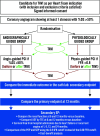A randomised multicentre study of angiography- versus physiologyguided percutaneous coronary intervention in patients with coronary artery disease undergoing TAVI: design and rationale of the FAITAVI trial
- PMID: 38629420
- PMCID: PMC11017223
- DOI: 10.4244/EIJ-D-23-00679
A randomised multicentre study of angiography- versus physiologyguided percutaneous coronary intervention in patients with coronary artery disease undergoing TAVI: design and rationale of the FAITAVI trial
Abstract
The treatment of coronary artery disease (CAD) in patients with severe aortic valve stenosis (AVS) eligible for transcatheter aortic valve implantation (TAVI) is not supported by clinical evidence, and the role of physiology over anatomy as well as the timing of coronary intervention are not defined. FAITAVI (ClinicalTrials.gov: NCT03360591) is a nationwide prospective, open-label, multicentre, randomised controlled study comparing the angiography-guided versus the physiology-guided coronary revascularisation strategy in patients with combined significant CAD and severe AVS undergoing TAVI. Significant CAD will be defined as coronary stenosis ≥50%, as assessed by visual estimation in vessels ≥2.5 mm. Physiology will be tested by fractional flow reserve (FFR) and instantaneous wave-free ratio (iFR). The study will be conducted at 15 sites in Italy. In the angiography arm, percutaneous coronary intervention (PCI) will be performed either before TAVI, during the TAVI procedure - before or after the valve implantation - or within 1 month±5 days of the valve implantation, left to the operator's decision. In the physiology arm, FFR and iFR will be performed before TAVI, and PCI will be indicated for FFR ≤0.80, otherwise the intervention will be deferred. In case of borderline values (0.81-0.85), FFR and iFR will be repeated after TAVI, with PCI performed when needed. With a sample size of 320 patients, the study is powered to evaluate the primary endpoint (a composite of death, myocardial infarction, stroke, major bleeding, or ischaemia-driven target vessel revascularisation). TAVI indication, strategy and medical treatment will be the same in both groups. After discharge, patients will be contacted at 1, 6, 12 and 24 months after the procedure to assess their general clinical status, and at 12 months for the occurrence of events included in the primary and secondary endpoints. FAITAVI is the first randomised clinical trial to investigate "optimal" percutaneous coronary intervention associated with TAVI in patients with severe AVS and CAD.
Conflict of interest statement
F. Ribichini has received honoraria from and is proctor for Edwards Lifesciences and Medtronic. G. Tarantini has received lecture fees from Medtronic, Edwards Lifesciences, Abbott, and Boston Scientific. The other authors have no conflicts of interest to declare.
Figures

References
-
- Goel SS, Ige M, Tuzcu EM, Ellis SG, Stewart WJ, Svensson LG, Lytle BW, Kapadia SR. Severe aortic stenosis and coronary artery disease--implications for management in the transcatheter aortic valve replacement era: a comprehensive review. J Am Coll Cardiol. 2013;62:1–10. - PubMed
-
- Bonow RO, Carabello BA, Chatterjee K, de Leon AC, Jr, Faxon DP, Freed MD, Gaasch WH, Lytle BW, Nishimura RA, O’Gara PT, O’Rourke RA, Otto CM, Shah PM, Shanewise JS 2006 Writing Committee Members; American College of Cardiology/American Heart Association Task Force. 2008 Focused update incorporated into the ACC/AHA 2006 guidelines for the management of patients with valvular heart disease: a report of the American College of Cardiology/American Heart Association Task Force on Practice Guidelines (Writing Committee to Revise the 1998 Guidelines for the Management of Patients With Valvular Heart Disease): endorsed by the Society of Cardiovascular Anesthesiologists, Society for Cardiovascular Angiography and Interventions, and Society of Thoracic Surgeons. Circulation. 2008;118:e523–661. - PubMed
-
- Reardon MJ, Van Mieghem, Popma JJ, Kleiman NS, Søndergaard L, Mumtaz M, Adams DH, Deeb GM, Maini B, Gada H, Chetcuti S, Gleason T, Heiser J, Lange R, Merhi W, Oh JK, Olsen PS, Piazza N, Williams M, Windecker S, Yakubov SJ, Grube E, Makkar R, Lee JS, Conte J, Vang E, Nguyen H, Chang Y, Mugglin AS, Serruys PW, Kappetein AP SURTAVI Investigators. Surgical or Transcatheter Aortic-Valve Replacement in Intermediate-Risk Patients. N Engl J Med. 2017;376:1321–31. - PubMed
-
- Leon MB, Smith CR, Mack MJ, Makkar RR, Svensson LG, Kodali SK, Thourani VH, Tuzcu EM, Miller DC, Herrmann HC, Doshi D, Cohen DJ, Pichard AD, Kapadia S, Dewey T, Babaliaros V, Szeto WY, Williams MR, Kereiakes D, Zajarias A, Greason KL, Whisenant BK, Hodson RW, Moses JW, Trento A, Brown DL, Fearon WF, Pibarot P, Hahn RT, Jaber WA, Anderson WN, Alu MC, Webb JG PARTNER 2 Investigators. Transcatheter or Surgical Aortic-Valve Replacement in Intermediate-Risk Patients. N Engl J Med. 2016;374:1609–20. - PubMed
-
- Vahanian A, Beyersdorf F, Praz F, Milojevic M, Baldus S, Bauersachs J, Capodanno D, Conradi L, De Bonis, De Paulis, Delgado V, Freemantle N, Haugaa KH, Jeppsson A, Jüni P, Pierard L, Prendergast BD, Sádaba JR, Tribouilloy C, Wojakowski W. 2021 ESC/EACTS Guidelines for the management of valvular heart disease. EuroIntervention. 2022;17:e1126–96. - PMC - PubMed
Publication types
MeSH terms
Associated data
LinkOut - more resources
Full Text Sources
Medical
Miscellaneous

